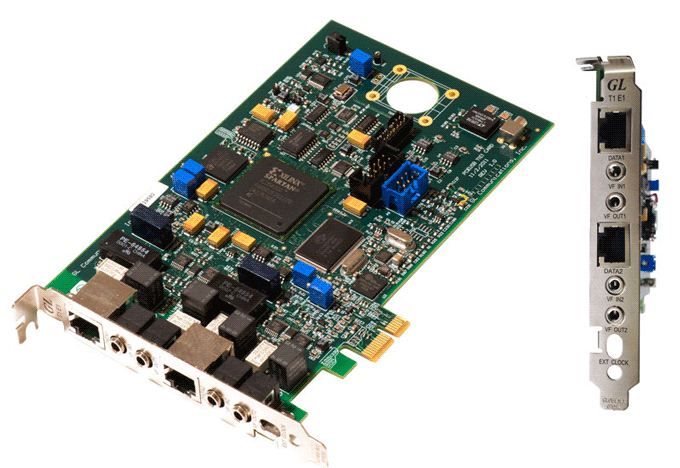GL Announces Dual T1 E1 Express (PCIe) Boards
Welcome to the first October 2014 issue of GL Communications' Newsletter providing information and insight into our latest T1 E1 Express (PCIe) Analysis & Emulation Boards.

Overview
GL's Dual T1 E1 Express (PCIe) Boards are high-density Dual T1 or E1 boards with newer PCIe (x1) bus interface. These cards are identical to the portable tProbe™ units except for FXO FXS and Datacom functionality.
In addition to basic T1 E1 applications and optional special applications, Dual T1 E1 Express (PCIe) Boards also support enhanced VF drop and insert with software selectable VF Tx and Rx impedances (135 Ω, 150 Ω, 600 Ω, 900 Ω, or High), Pulse Mask Compliance , Jitter Generation and Measurement testing applications.
Important Applications / Features:
- Software Selectable T1 or E1 interfacing along with Drop / Insert
- PCI Express x1 Lane/Board
- Monitor the T1 E1 line conditions such as frame errors, violations, alarms, frequency, power level, and clock (or frame/bit) slips
- CAS, ISDN, SS7 and other TDM Protocol Analysis and Emulation
- VoIP, Frame Relay and Multilink Frame Relay, PPP and Multilink PPP, HDLC Applications
- Routing and Bridging emulation over Multi T1 E1 WAN interfaces using MLPPP (Multi Link PPP) and MFR (Multi Link Frame relay) Protocols
- Most all "basic applications" and "special applications" available for Dual T1 E1 Express identical to the portable tProbe™ units, except for FXO FXS and Datacom functionality
- Comprehensive Analysis / Emulation of Voice, Data, Fax, Protocol, Analog, and Digital signals, including Echo and Voice Quality testing
- Call Recording, Generation, and Monitoring for hundreds to thousands of calls in one platform
- Supports T1 E1 Pulse Mask and Jitter Generation and Measurement Analysis
- "Cross-port Through" and "Cross-port Transmit" Modes - ease cabling with Drop/Insert and Fail-Safe Inline Monitoring
- Enhanced VF Drop and VF Insert Capabilities using 3.5mm Balanced (Stereo), or Unbalanced (Mono) physical connections
These cards are available with user-friendly GUI for Windows® 7 / 8 operating systems with support for almost all existing T1 E1 Analyzer applications including Comprehensive Analysis / Emulation of Voice, Data, Protocol, Digital, and Echo Testing.
Comparison / advantages of the new Dual T1 E1 Express (PCIe) Boards over other GL's PCI based T1 E1 Cards are given in the following table.
| Feature | Quad, Octal T1 E1 Boards | Dual T1 E1 Express (PCIe) Boards |
|---|---|---|
| Number of Ports | 4, 8 | 2 |
| PCI Slot Type | PCI Express x1 Bus/ Connector | PCI Express x1 Bus / Connector |
| Speaker (on board) | No speakers | Supported |
| Cross-port and Through Modes | Supported | Supported |
| Pulse Mask Application | Not Supported | Supported |
| Jitter Generation and Measurement | Not Supported | Supported |
| External Clock Mode | No clock port connector | Supported |
| Clock Offset Capability | All ports at the same time | 1 Port at a time |
| VF Interface and Impedance | Not Supported | Supported; 135/150/600/900/High |
| VF Interface for Mic/Headset | Not Supported | Supported |
| Drop and Insert (VF and T1 E1) | No VF connectors; Digital Drop/Insert supported | Supported |
| Onboard RAM | Not Supported | Supported |
GL offers other popular forms of T1 E1 analysis hardware:
- tProbe™ T1 E1 Analyzer Unit - an enhanced version of USB based T1 E1 VF & Serial Data analyzer with expansion capabilities,
- Octal/Quad T1 E1 Analyzer Boards - 4 / 8 ports PCIe based cards for higher scalability and performance
- tScan16 - a high-density T1 E1 board with 16 ports and the newer PCIe (x1) bus interface
 Back to Newsletter Index Page
Back to Newsletter Index Page